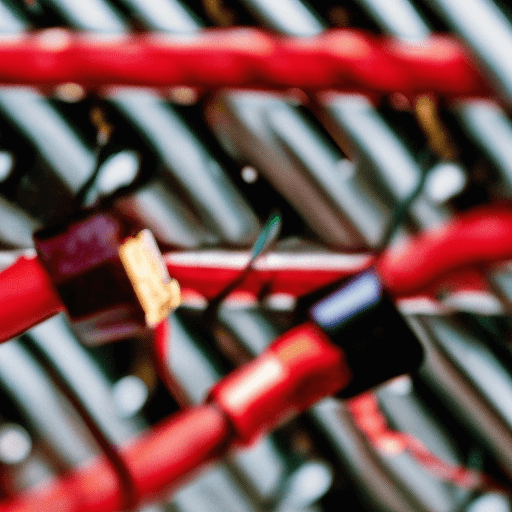Is black positive or negative?
Stay safe by knowing which colors are positive and which ones are negative!
The colors of wires can tell you a lot about the device or system it is connected to.
Each color has a different meaning and can be positive or negative.
Let’s go over the colors of wires and what they mean.
When talking about wires, black has a specific meaning—it is the color that indicates negative polarity.

The black wire in electrical wiring is traditionally used to denote the negative, or ground side of the wiring.
Wires are typically marked with colored insulation or paint in order to make it easier for engineers and technicians to identify them quickly when wiring up components or systems.
The reason for this convention comes from electrical engineering, as it is important to have an easy way to differentiate between the positive and negative voltage on a circuit.
Is black positive or negative?
In most cases, you will see black indicating the negative terminal and red indicating the positive; though occasionally you may also find white connected to the negative line (for example in some car audio systems).
On electrical wiring, the black wire is commonly used to denote the hot or live wire, which carries the positive current.
7 important points about positive and negative wires in electrical systems:
- Black wires are used for the hot connections in an electrical circuit. These bring the power from the source and are positive.
- White or light gray wires are used as the grounded neutral returns. These complete the circuit back to ground and are negative.
- The actual direction of current flow oscillates rapidly in AC power. But by convention, the black is called “hot” and seen as positive.
- In DC circuits, current truly flows from positive to negative. But wire colors still follow the same conventions.
- Green or bare copper wires are used as ground connections for safety.
- Red wires can indicate a second hot line in three-way switching set-ups.
- Wire nuts, tape, or crimping is used to keep positive and negative wires properly isolated.

So while the black color itself is not inherently positive or negative, standard wiring conventions establish black as the positive, live wire in most electrical systems. This provides consistency and safety.
Explain it to a child
The color black is used to indicate negative polarity in wires. This is because it is easy to differentiate between the positive and negative voltage on a circuit.
This color coding method is easy to remember and allows any trained electrician to quickly identify which wire is positive and which is negative so that components can be wired correctly and safely.
Many cables have black insulation coating the copper, but this should not be confused with black being a designator for positive, as it usually means negative.
There are special circumstances where black wires may indicate positive instead such as if leading to a fuse box.
Still, it’s always best practice to double-check with a qualified professional before handling a wiring job.
Why black is used for negative polarity

The color black represents negativity due to practical reasons.
- Many electrical wires are black because black wires are used as negative or ground wires in any electrical circuit.
- This is logical, as black symbolizes something that is “down” or “away” from other light-colored objects, including the color white, which would typically represent a positive charge or “up” motion.
- As black is so associated with electricity and the negative charge that it carries, it has come to be a popular choice of color among those looking to express a darker side when considering artwork or fashion.
In other words, black has become a symbol of negativity over time due to its original use in an electrical context.
How to identify positive and negative wires?

Learning how to identify positive and negative wires correctly is an important skill for many DIY-ers.
By understanding the basic principles of how electricity flows and how it interacts with magnetic fields, it becomes much easier to distinguish which wire is which.
- Specialized testers and detectors can be used for more accurate results, however, even without these pieces of equipment, you can use a voltage meter or multimeter to check the polarity and flow of electrons in the wires—if there is a continuous circuit the potential differences between both the negative and positive wires should be found within approximately one volt.
- Additionally, most modern wiring systems have color-coded insulation, with red typically indicating a positive connection and black or white corresponding to a negative connection.
- Finally, if all else fails you can perform a continuity test, using either batteries or an outlet’s current supply can indicate which wire is carrying the current through this process of elimination.
Other colors that may be used for negative wiring

When wiring a device, the use of color coding is an important tool.
In many installations, the code involves using red for positive wiring and black for negative wiring.
However, in some cases, other colors may be used for negative wiring.
- White
- Gray
- Yellow
- Green
These are all possible alternate colors that can signify a negative line in a wire harness.
Each option serves its own purpose depending on the context of the installation.
Ultimately, when it comes to ensuring absolute accuracy and safety while wiring, understanding the accepted color codes not just for positive but also for negative lines is critical.
How wires are typically marked with colored insulation or paint

Wires are an integral part of many electrical systems and identifying them quickly and accurately is vitally important.
To make identification easier, wires are typically insulated with variously colored plastics or paints.
Different insulation colors will signify different gauge sizes and resistances which makes it much easier for engineers to work with the wires.
Even in the absence of specific color guidelines, certain insulation materials can be used to denote certain types of wire; for example, when only white insulation is available it is commonly used for the neutral wire.
The use of colored insulating materials assists electrical engineers in not only ensuring accuracy within their system but also ensuring that the process is a lot quicker.
Article Sources
Jacks of Science sources the most authoritative, trustworthy, and highly recognized institutions for our article research. Learn more about our Editorial Teams process and diligence in verifying the accuracy of every article we publish.
